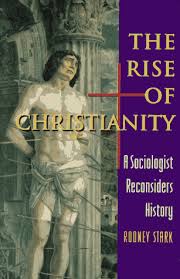
He asks obvious questions — but that are only obvious once someone has asked them. For example, he has a chapter that starts with a thousand Christians in the first century, and notes the number of Christians there likely were when Constantine officially abandoned paganism. He then asks the obvious question — what growth rate was necessary in order to get between that first point and the second one?
Another chapter examines the likely class status of converts to Christianity. Contrary to class struggle advocates, the gospel grew the way it did, and was as effective as it was, because it appealed strongly to the middle and upper classes. Christianity was as appealing as it was because of its work with the outcasts, but there was a strong appeal in this to those who were not outcasts.
This relates to another chapter. Stark examines the impact of deadly epidemics on the growth of Christianity. Pagans would scatter and flee at the first sign of an outbreak, and Christians would not. Christians would stay and minister to the sick, and despite this — and as Stark shows, because of this — the Christians had a much better recovery and survival rate. This meant that recovered Christians, now immune, could continue the task of nursing the sick.
Because of the adamant stance of the Christians against abortion and infanticide, they had a robust female population, and the pagans didn’t. This was because infanticide was frequently — as abortion is today in places like China — a means of selecting against females. In this context, the Christians had a lot more women, and they honored them highly.
The book is not perfect, and some of this is the result of certain realities not yielding to quantification. Another reason for the occasional stumble is that Stark is not as careful as he ought to be one the question of women holding church office. He is right about how the women were honored, but wrong about whether they wielded authority in the church. A deaconness in the early church was not a deacon who happened to be a woman.
Nevertheless, with all this said, this is a book that begins with some mundane number crunching, and moves on to treat some fascinating subjects, and in a way that is quite moving.


“a thousand Christians in the first century”
Who was the first Christian?
Was Mary a Christian?
Simeon? Luke 2:25
John the Baptist?
Isaiah?
Job?
Abel?
Adam?
I read this book twice in seminary. It is a very worthwhile read. His section about the success of the ministry to the Jews is both counterintuitive and very convincing. Also, his description of the urban environment that birthed Paul’s ministries is very insightful. He frequently compares Christianity’s rise to the current increase in Mormonism, and here he makes some unjustified leaps. But again, he makes his reader think about the topic in a fresh way.
While I do agree with Start that there was ministry success with regard to the Jews in the diaspora, I think the evidence is strongly against him on one of his primary reasons of support for that. He assumes Christianity was against Torah observance for Jewish believers and goes on to talk of why this would be attractive for Hellenized Jews. However, everything I’ve learned lately from studying the Jewish aspects of 1st-5th century Christianity is that they were for Torah observance.